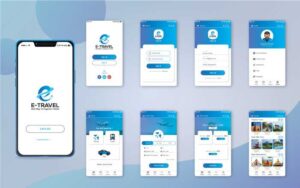
If you have an innovative brain and love technology, the best place you can think about getting into is UX and UI design jobs, one of your dream careers. These combine creativity and problem solving with design principles for the user, leading to creating a seamless digital experience. From apps to websites, UX and UI designers help shape digitised ways that people find and consume them.
In this article, we’ll talk about the job description of these roles, the many kinds of skills required, and how to get your first job in this enriching profession.
What Are UX and UI Design Jobs?
Designing jobs related to UX is how a specific user feels while interacting with a product. It involves doing thorough research, creating wireframes, and testing the product to ensure the user’s need is met. Meanwhile, UI design deals with making interfaces visually appealing and intuitive to use.
Often professionals work within a shared UX/UI design job that takes care of both specialisms to give holistic digital experiences.
Why Pursue a Career in UX and UI Design?
- High demand as companies focus on user-friendly designs.
- Great impact on business success.
- Creative freedom in design.
- Competitive salaries for skilled designers.
- Flexible work options, including remote jobs.
Key Skills Needed for UX and UI Design Jobs
| Skill | Description |
| User Research | Understanding user needs, behaviors, and pain points to create better experiences. |
| Wireframing and Prototyping | Sketching ideas and building interactive prototypes to test design concepts. |
| Design Software Proficiency | Mastering tools like Figma, Sketch, and Adobe XD for creating designs. |
| Visual Design | Applying principles of layout, typography, and color theory to enhance user experience. |
| Communication Skills | Collaborating with teams, presenting ideas, and gathering feedback effectively. |
How to Get Started in UX and UI Design
If you are a novice at UX and UI designing, it doesn’t matter; every person has a starting point. Start learning some fundamentals through online courses from platforms such as Coursera or Udemy. Practice with personal projects to establish your portfolio, which includes an excellent show of best works for those potential employers. Network yourself-attend design meetups and connect with other designers, then apply for internships for experience and to kick-start your career.
Building a Strong Portfolio for UX/UI Careers
The portfolio is supposed to be your ticket to getting hired in UX and UI design. Your portfolio should feature elaborate case studies that display your design process and problem-solving abilities. Include different projects that will speak for your versatility. Use attractive visuals to lure attention to your work. Most importantly, mention the difference that your designs made by presenting measurable results. A compelling portfolio will work wonders in attracting the right opportunities.
Where to Find UX and UI Design Jobs
- Explore job boards like LinkedIn, Glassdoor, and Indeed.
- Look for freelance gigs on Upwork and Fiverr.
- Check company websites for open positions.
- Network with professionals to discover hidden opportunities.
Interview Tips for UX and UI Design Roles
Preparation is everything once you have made it to the interview. Find out everything possible regarding the company’s products and designing style so as to enable them to understand what they need. Prepare to discuss your design process and the way you deal with problems. Present your best work from your portfolio. Asking some intelligent questions will also reflect upon your interest in the design needs of the company.
Advancing Your Career in UX and UI Design
- Specialize in areas like interaction design or accessibility.
- Keep up with the latest design trends and tools.
- Learn from experienced designers through mentorship.
- Attend workshops and conferences for continuous growth.
- Take on challenging projects to expand your skills.
Freelance vs. Full-Time UX/UI Design Jobs
| Freelance | Full-Time |
| Flexibility to choose projects | Job security and stability |
| Work on your own schedule | Opportunities for teamwork and collaboration |
Challenges in UX and UI Design Careers

Any career comes with its challenges, and even that of the UX and UI Professional has its own arenas of conflict-dated timelines, opposing views from stakeholders, and the constant and pressing demand to stay updated on changing trends in design. However, most of the time, the rewards and satisfaction offset these challenges.
Essential Tools for UX and UI Designers
- Figma: A versatile design tool for real-time collaboration.
- Sketch: Perfect for UI design with a user-friendly interface.
- Adobe XD: A comprehensive tool for design and prototyping.
- InVision: Great for creating interactive prototypes and gathering feedback.
UX and UI Design Trends to Watch
The industry is always changing, and so is the trend to follow. Dark modes are becoming an increasing trend as they keep the eyes of the user in mind. Voice user interfaces are also pulling in more recognition and acceptance. Just like micro-interactions, where small animation comes into play, these so perfectly engage the user and enrich the overall experience. If you stay in sync with trends, you will have an upper hand in the industry.
The Future of UX/UI Career Paths
- The demand for UX/UI designers is steadily increasing.
- Virtual reality is shaping immersive user experiences.
- AI-driven design is enhancing personalization and automation.
- Voice and gesture-based interfaces are gaining popularity.
Conclusion
UX/UI design gives a vibrant and challenging career to any creative individual. With the right skills, a well-built portfolio, and current knowledge of trends, one can find success therein. Numerous opportunities are available for entry-level designers or even those who are already working but want to move forward simply because they are interested in creating user-centered designs.
With an increased focus on digital experiences, companies have shifted even more toward ensuring usability and intuitiveness; hence, top designers are much sought after.
FAQs
What are the dissimilarities between UX and UI designs?
UX design is concerned with the whole embodied experience a user has with an object or system, while UI design only considers the pages and interactive components in relation to the product.
What Do I Need to Know Before Taking a UX or UI Design Job?
User research, wireframing, visual design, and communication, and knowledge of design tools like Figma and Adobe XD are included in the skill set.
How to Build a Strong Portfolio for UX/UI Jobs?
It should include case studies, a range of projects and polished visuals. Showcase how you solved problems and the impact of your designs.
Are UX and UI design jobs in demand?
Yes, the demand for skilled UX and UI designers is high as businesses prioritize user-friendly digital products.
Can I work remotely as a UX/UI designer?
Absolutely! Many companies offer remote roles, and freelance opportunities are abundant in this field.